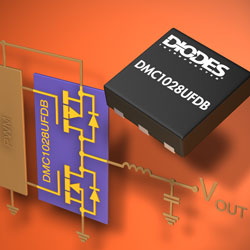To improve the power density of DC-DC converters, Diodes Incorporated's DMC1028UFDB complementary MOSFET pair integrates N-channel MOSFETs and P-channel MOSFETs in a single DFN2020 package.
The design is customized for point-of-load (POL) converters, which step down from 3.3V to 1V to provide the core voltage for the ASIC. Target applications are Ethernet controllers and processors used in routers, network interface controllers (NICs), switches, digital subscriber line (DSL) adapters, servers, and set-top boxes (STBs).
The buck converter implemented using a separate PWM controller and external MOSFETs enhances design flexibility and provides distributed heat dissipation of the switching elements. The performance parameters of the DMC1028UFDB MOSFET have been optimized to achieve maximum efficiency in a 3.3V to 1V buck converter while driving loads up to 3A. These characteristics include: the low-side N-channel MOSFET has a low Rds (on) of 19mohm at Vgs = 3.3V, and is in the on state for most of the two-thirds of the switching cycle; for the P-channel MOSFET, the Vgs = 3.3V with a low gate charge (Qg) of 5nC to minimize switching losses.
DMC1028UFDB uses P-channel MOSFETs to implement high-end switching elements. Compared with N-channel MOSFETs that require a charge pump, it simplifies the design and reduces the number of components. The company said that combining P-channel and N-channel devices as complementary MOSFET pairs in a single DFN2020 package can double the total power density compared to a single MOSFET in the same package.
